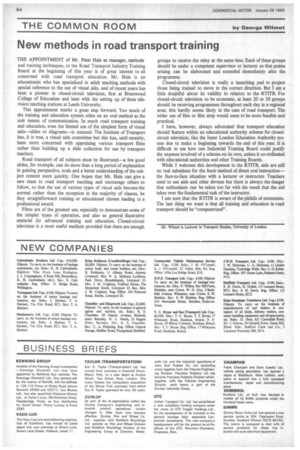New methods in road transport training
Page 66

If you've noticed an error in this article please click here to report it so we can fix it.
THE APPOINTMENT of Mr. Peter Hale as manager, methods and training techniques, to the Road Transport Industry Training Board at the beginning of this year is of great interest to all concerned with road transport education. Mr. Hale is an educationist who has specialized in adult teaching methods with special reference to the use of visual aids, and of recent years has been a pioneer in closed-circuit television, first at Brentwood College of Education and later with the setting up of three television teaching stations at Leeds University.
This appointment marks a great step forward. Too much of the training and education system relies on an oral method as the sole means of communication. In much road transport training and education, even the limited use of the simplest form of visual aids—slides or diagrams—is unusual. The Institute of Transport has, it is true, a visual aids committee but this has, until recently, been more concerned with appraising various transport films rather than building up a slide collection for use by transport teachers.
Road transport of all subjects must be illustrated—a few good slides, for example, can do more than a long period of explanation in gaining perspective, scale and a better understanding of the subject content more quickly. One hopes that Mr. Hale can give a new slant to road transport teaching and encourage others to follow, so that the use of various types of visual aids become the normal rather than the exception in the majority of classes, be they straightforward training or educational classes leading to a professional award.
Films are of the greatest use, especially to demonstrate some of the simpler types of operation, and also as general illustrative material for advanced training and education. Closed-circuit television is a most useful medium provided that there are enough groups to receive the relay at the same time. Each of these groups should be under a competent supervisor or lecturer so that points arising can be elaborated and extended immediately after the programme.
Closed-circuit television is really a launching pad to project those being trained to move in the correct direction. But I am a little doubtful about its validity in relation to the RTITB. For closed-circuit television to be economic, at least 20 or 30 groups should be receiving programmes throughout each day in a regional area; this hardly seems likely in the case of road transport. The wider use of film or film strip would seem to be more feasible and practical.
I have, however, always advocated that transport education should feature within an educational authority scheme for closedcircuit television, like the Inner London Education Authority system due to make a beginning towards the end of this year. It is difficult to see how one Industrial Training Board could justify the expense involved of a scheme on its own, unless it co-ordinated with educational authorities and other Training Boards.
While I welcome this development in the RIM, aids are still no real substitute for the basic method of direct oral instruction— the face-to-face situation with a lecturer or instructor. Teachers need to use aids and other devices but there is always the danger that enthusiasm can be taken too far with the result that the aid takes over the fundamental task of the instructor.
I am sure that the RTITB is aware of the pitfalls of extremism. The last thing we want is that all training and education in road transport should be "computerized".












































































































